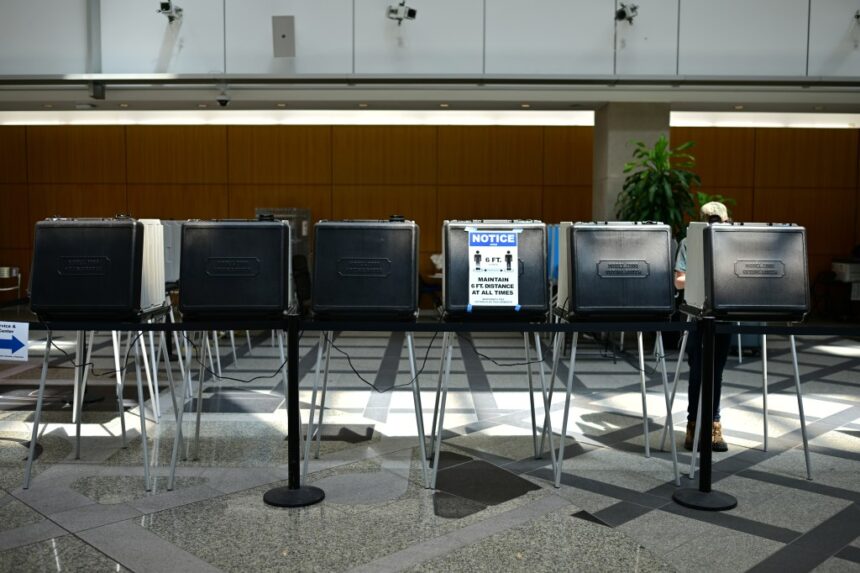Andy Cohen, a 41-year-old co-founder of a public affairs firm in Denver, is tired of the negativity about an economy that, by most metrics, is glowing — even as he noted a dip in his own business to close out 2023, and acknowledges that affordability remains a challenge in Colorado.
Steve Brewer, 64, who runs a small IT consulting firm out of Centennial, acknowledges that inflation has slowed since its peak last year, but worries “the damage is already done” when it comes to high prices.
For both, the economy and cost of living are one of — if not the — top issues as they fill out their ballots for the Nov. 5 election. It’s a common refrain from voters both nationally and through responses to The Denver Post’s ongoing Voter Voices survey, carried out in partnership with other media outlets through the Colorado News Collaborative.
The two voters, albeit both white-collar professionals, also illustrate some of the ways different people view the economy as they weigh the presidential candidates in particular.
On the surface, the economic statistics don’t seem to back up a sense of worry. People who own their homes, about two-thirds of the population, are enjoying unprecedented gains in wealth from higher home prices. Stock values are trading at record highs, shoring up retirement portfolios.
Colorado’s unemployment rate, while rising this year, remains at a low 4%. There are about 1.6 job openings for every unemployed worker in the state. Colorado job growth lags the pace seen in other states, but employers have added 194,000 jobs since 2019, defying repeated predictions for a downturn.
The country has created more jobs, in both the public and private sectors, during President Joe Biden’s term than under any other administration, according to the economics blog Calculated Risk. Part of those gains reflects the rebound from the pandemic, which helped turn earlier gains under then-President Donald Trump’s administration negative.
So why so much angst about the economy when so many things are going right?
It comes down to one word — inflation.
“When I look at my monthly stock market account, I am pleased. When I go to a restaurant, I see smaller crowds. When I go to the grocery store, I sometimes cringe,” said Broomfield economist Gary Horvath.
The toll of inflation on households
Although the last two inflation reports for metro Denver have come in at a tame annual rate of 1.4%, the surge in 2022 and 2023 has harmed household budgets, according to the Inflation Misery Index published by the Common Sense Institute, a business-oriented think tank.
The index estimates that the average person in Colorado must spend $10,451 more per year, about 13% of their annual income, to consume the same quantity of goods and services they did in 2019. Inflation averaged 2.19% a year before the pandemic. Subtract that “normal” inflation out, and the average Coloradan must spend $5,060 more per year or 6% of their income due to “excess” inflation, according to CSI.
Compounding matters, consumers who turned to revolving debt like credit cards to keep up are having to cope with higher payments following interest rate hikes by the Federal Reserve to tame inflation.
“As we look at a very complex and busy ballot, I think it is important for people to consider the cost of everyday goods and how their purchasing power has declined. That matters and it should be an input into decisions at the ballot box,” said Kelly Caufield, Colorado executive director at CSI.
Colorado households are spending $5,134 more a year for housing and utilities, $5,582 more for food, $2,104 more for recreation and $515 more for gasoline than in 2019, according to the index.
But are they? For example, a family with a fixed mortgage payment wouldn’t have seen that change, although property taxes and insurance premiums cost more than four years ago. If consumers weren’t in the market for an automobile since 2020, then higher new and used car prices wouldn’t be at play for them, at least not yet.
Inflation is much more troublesome when income gains don’t keep up. Many employers peg annual pay raises to increases in the cost of living, and the tight labor market offers them a motivation to keep up.
Colorado’s average hourly wage has about matched increases in consumer inflation, whether starting in 2019 and 2020. Looking at changes from 2022, when inflation heated up, through this summer, wages have risen more than the Denver Consumer Price Index, but with a bit of lag, according to the U.S. Bureau of Labor Statistics.
Zachary Milne, a CSI economist and co-author of the CSI Misery Index, said consumers had been enjoying a downward trend in the total share of income required to support their living expenses, only to see it reverse the past five years.
“You are better off than you were 20 years ago, but you aren’t better off than you were five years ago. It has become so much more expensive to live today,” he said.
Voters weigh memories, post-Biden promises
Cohen, an unaffiliated voter who describes himself as left of center, sees an overall upward trajectory for the economy in Colorado and, in general, thinks presidents get too much credit or blame when things go sour. But he also likes the overall philosophy of investing in technological innovation, particularly in response to climate change.
“While still kind of nebulous on both sides, there are distinct differences between both candidates,” said Cohen, who plans to vote for Vice President Kamala Harris. “I tend to find the message of positivity and moving forward and looking for ways to make our economy innovative and robust and bleeding-edge, really appealing.”
And, taking a shot at the former president, Cohen added, “I need more than tariffs and concepts of a plan.”
He does give credence to the idea of a “vibecession,” or the feeling that economic conditions are worse than they are. People experience economic growth and inflation differently, he said. But also, the stock market hit record highs under the Biden administration, unemployment remained low and national economic growth continued to outpace other developed countries.
For Cohen, he thinks the economy has reached “a point of relative stability” after pandemic-era jolts. And he feels it personally, with his own business picking up this year.
Brewer, who registered as a Republican about a decade ago after years of not affiliating with a party, fondly recalls the pre-pandemic economy under Trump as a time when his own business was booming and prices were much lower. Then, he could go out for a decent dinner for around $50; now, he plans for twice that when the check comes. He pins the inflationary spike on excess government spending during Biden’s first two years in office.
Biden’s signature policies — the American Rescue Plan, the Inflation Reduction Act and the Bipartisan Infrastructure Law — collectively cost trillions of dollars. They paid for tax credits for low-income people and to spur business development, infrastructure and green energy projects, and pandemic-era assistance, albeit with various offsets in the form of tax increases and collections.
Brewer credits Republicans retaking control of the U.S. House of Representatives, and effectively putting a kibosh on more big-ticket proposals, with slowing the spending down.
“If Kamala Harris gets in, it’s just going to be more of the same. If anything, I feel like it’s going to be worse,” Brewer said, saying he sees her continuing policies of giving money “to people who may or may not deserve it.”
Meanwhile, he points to Trump’s time in office as leading to less government interference in business and tax cuts. Trump’s promise of increased tariffs, which have been panned by economists and raise the hackles of some pro-free-trade conservatives, don’t concern Brewer, either — not when he can point to a record from just a few years ago.
“The things (Trump) says he’s going to do, he does, and they’re usually with good effects,” Brewer said.
Economy drives campaigns
The two major presidential candidates have pitched different economic plans that a nonpartisan analysis found could add trillions to the national debt over 10 years — $3.5 trillion for Harris and $7.5 trillion for Trump, depending on exactly how their plans are implemented.
Both campaigns argue economic growth spurred by their policies would more than make up the gap.
Trump has made tariffs, or taxes on goods imported into the country, a centerpiece of his re-election campaign. He argues the tariffs would force businesses to manufacture goods in the United States again, and bolster the government’s coffers through extra income.
Harris’ plans have appeared more targeted, including $25,000 in down-payment assistance for some first-time homebuyers, a federal ban on price gouging, expanding the earned income tax credit for low-income people and the child tax credit for families, and leveraging the Affordable Care Act to fight rising health insurance costs.
Stay up-to-date with Colorado Politics by signing up for our weekly newsletter, The Spot.
Originally Published:










